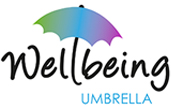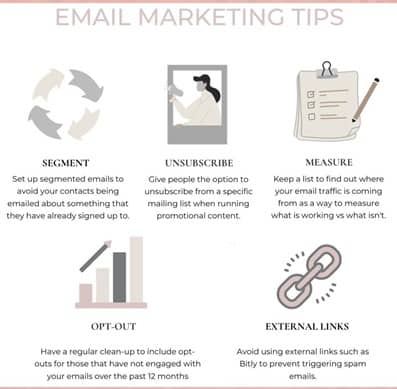Email Marketing Low Open Rate & How To Avoid It
30th Jun 21
The big question we’d all want answered – ‘how do you improve your email’s low open rate!’
You may have seen that I will often refer to email marketing and how it’s such a wonderful tool. Especially, to share your content without having to pay a dime. And when I say a dime I mean the cost to run a FB ad or a boosted post – have you been tempted to do this too?
But here’s the thing that many of you may feel stuck with. Especially when it comes to getting people to read your emails and improve your open rate:
- Many of you may not know how to measure your email campaigns. Rendering you unable to see what is performing well and what isn’t;
- You don’t know what an average good email ‘open rate’ is;
- You don’t what action to take to avoid your emails going to your subscriber’s junk inbox;
- You’re unsure what email to even send;
- You’re not sure what your audience wants to hear about.
OR, perhaps you’re someone that has adopted the mindset with something like “why would my subscribers want to hear from me?!” – yup, I’ve been there myself!
Have you been falling fowl of a low open rate?
If you fall into any of the above categories, that’s completely OK! Please be kind to yourself; we all have to start from somewhere. I’ve been doing this a long time now, and it’s my job to know about these things. So, please don’t beat yourself up if your emails aren’t performing particularly well. We are all a work-in-progress when it comes to getting our content spot on.
But, hey I’m going to try my best to help you with that throughout this blog.
But, before we do that let’s explore this a little further before we jump into tips that will help you to improve your email lists, content and open rates.
First and foremost, many businesses assume that email marketing is solely about promoting their business. Unfortunately, I hate to be the bearer with bad news, but this isn’t necessarily true. Whilst it’s a fantastic way to get your business seen, the trick is in the value that you share. This is going to help you to build trust and credibility. Take Facebook spam messages as an example;
How does it make you feel when you get a Facebook friend request from someone that appears to run a business of their own only to then find that as soon as you accept their request; you then get a direct message from the same person selling you something! Does it niff you off? Does it make you jump right into whatever they’re selling? Generally, many of us won’t like this way of selling but it will also come down to how you approach the conversation too.
Everyone will feel differently about this, but I know for me as a connector I value relationships first. If I want to buy something, I will likely go looking for it rather than being poached about it.
Something to ponder on anyway.
Ok, so let’s get to the good stuff! Here are 5 handy to know tips to keep in mind when sending your next email marketing campaign. They’ll help you avoid email low open rates and triggering potential spam.
Tip 1: Keep your email subject line short, concise and to the point.
I like to think of this approach as a “do what it says on the tin” kinda thing.
Keeping email subject lines short can feel difficult at times, especially when the content subject matter is rather detailed! Do you know what I do when I feel stuck? I use the following free Email Subject Line Generator, to give me some tips on how to position my subject line.
What will this do? This will help to get more eyes onto your email content by grabbing your reader’s attention in the best possible way.
Tip 2: Keep your content relevant
It’s always best practise to get a feel for what your audience is particularly interested in. More so if you’re a multi-hat business, or if you offer more than one service or product. You can easily achieve this by setting up interest groups or tags within your email marketing system. An example is that if someone has a keen interest in knowing about EFT or skin care for acne (2 very different topics I know!) than you know what content to send out to whom. This will make your future sale so much easier.
Alternatively, you could also look into see where the source is coming from. Let’s say that you’ve offered out a freebie that delivered a meditation specifically for trauma-based issues – then this is generally a good indicator to keep your content relevant to that. This is what is known as segmenting your email lists. More on that in my Mailchimp course.
Tip 3: Improve low open rate – make it skimmable
How many long emails do you read? Ok, maybe the odd one or two. And that’s is probably only because you know that person provides amazing value. However generally speaking not a lot of us have time to sit and read every word in an email. It’s not personal, we’re just busy bees.
One tactic is to provide easy-to-read email content. This so your audience can grasp the overall message without having to read the entire email. Another way is to include images or even infographics to help break up the text and highlight key points.
Essentially, the goal here is to try and cut through the clutter of your subscriber’s inbox
Tip 4: Avoid potential SPAM triggering content
How on earth am I meant to know that? You might ask.
The good news is that a lot of email marketing provider tools will spam check it for you – here’s an example of a sentence that got picked up as potential spam.
Alternatively, try avoid using words that are all in CAPITAL LETTERS, lots of exclamation marks!!!! Heavy images, or even Bitly links! << Yes I know, right! These are the ones I know of right now, but you can check-out Mailchimp’s guide on how spam filters work and how to avoid them by clicking here.
Tip 5: Give your audience a chance to opt-out of promotional type emails.
Oooo this is a biggie – one I believe will really help to improve with low open rates.
Let’s say that you’re running an upcoming 5-day challenge, an event, a sale or just general promotional content. You can give your audience the choice to opt-out of these emails and only email those that are genuinely interested in taking action. Unfortunately, well not so much unfortunately, but not ideal for those of you that want to target a specific product or service – but we’ll always have people that follow us for our free content with little intention to buy and those that are ready to buy now, there’s not a lot that can be done with this other than to keep providing good value with the intention that one day they’ll be ready to buy.
You can do this using tools such as Mailchimp or Active Campaign. I’m pretty sure that other email marketing providers will also give you this option. So let’s say someone chooses to opt-out of a specific offer that you’re running that week. It doesn’t mean that they are unsubscribing from your emails. Instead, it just means that they might not be in a position to buy it this time around.
What does the opposite of a low open rate look like?
The answer really depends on the industry that you’re in, but I’d say a 20% open rate is a relatively healthy one. However, try not to get too hung up on the number to begin with as you may find that it will fluctuate whilst you try out different techniques to get your email marketing on the right track.
If you’d like to dig into open rate stats a little deeper, here is an article I found that will give you a breakdown based on industry, check-it out here.
There’s really so much I can speak on this topic, but I’d be here a long time writing this blog 🙂 so if you’d like to know more, what I’d like to suggest if I may, is to follow my next blog that will be focused on “popular email content topics to write about”, which will become available at the end of May 2021. Alternatively, check out my courses here to grab my free email marketing webinar to get access to this kind of support now.
I’d love to know if this was of any help, please leave me a comment below to let me know your feedback or if there is something in particular that you’d love to know more about.
Until then, see you next month.
Disclaimer: The information contained within this article is for general information purposes only and does not constitute advice on which you should rely. Professional or specialist advice should always be sought before taking any action relating to your business. Read full website terms of use.

















